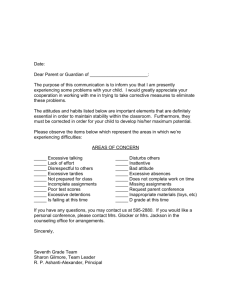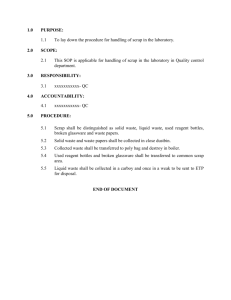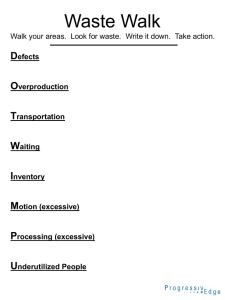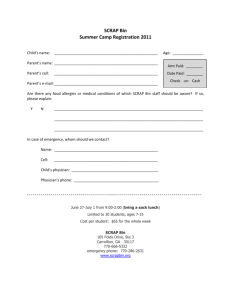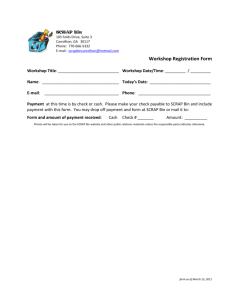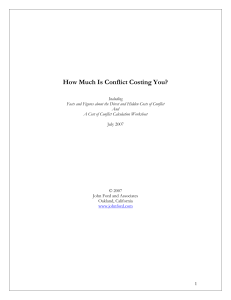Possible Needs Analysis Solutions
advertisement
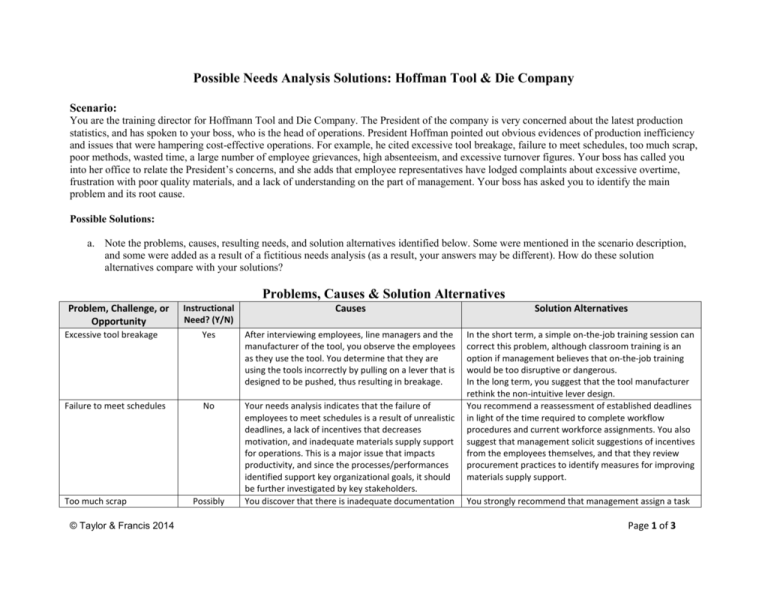
Possible Needs Analysis Solutions: Hoffman Tool & Die Company Scenario: You are the training director for Hoffmann Tool and Die Company. The President of the company is very concerned about the latest production statistics, and has spoken to your boss, who is the head of operations. President Hoffman pointed out obvious evidences of production inefficiency and issues that were hampering cost-effective operations. For example, he cited excessive tool breakage, failure to meet schedules, too much scrap, poor methods, wasted time, a large number of employee grievances, high absenteeism, and excessive turnover figures. Your boss has called you into her office to relate the President’s concerns, and she adds that employee representatives have lodged complaints about excessive overtime, frustration with poor quality materials, and a lack of understanding on the part of management. Your boss has asked you to identify the main problem and its root cause. Possible Solutions: a. Note the problems, causes, resulting needs, and solution alternatives identified below. Some were mentioned in the scenario description, and some were added as a result of a fictitious needs analysis (as a result, your answers may be different). How do these solution alternatives compare with your solutions? Problems, Causes & Solution Alternatives Instructional Need? (Y/N) Causes Solution Alternatives Excessive tool breakage Yes After interviewing employees, line managers and the manufacturer of the tool, you observe the employees as they use the tool. You determine that they are using the tools incorrectly by pulling on a lever that is designed to be pushed, thus resulting in breakage. Failure to meet schedules No Your needs analysis indicates that the failure of employees to meet schedules is a result of unrealistic deadlines, a lack of incentives that decreases motivation, and inadequate materials supply support for operations. This is a major issue that impacts productivity, and since the processes/performances identified support key organizational goals, it should be further investigated by key stakeholders. You discover that there is inadequate documentation In the short term, a simple on-the-job training session can correct this problem, although classroom training is an option if management believes that on-the-job training would be too disruptive or dangerous. In the long term, you suggest that the tool manufacturer rethink the non-intuitive lever design. You recommend a reassessment of established deadlines in light of the time required to complete workflow procedures and current workforce assignments. You also suggest that management solicit suggestions of incentives from the employees themselves, and that they review procurement practices to identify measures for improving materials supply support. Problem, Challenge, or Opportunity Too much scrap © Taylor & Francis 2014 Possibly You strongly recommend that management assign a task Page 1 of 3 Problem, Challenge, or Opportunity Instructional Need? (Y/N) Poor methods Yes & No Wasted time No Large number of employee grievances, complaints about excessive overtime, and frustration with poor quality materials and management’s apparent lack of concern No High absenteeism, excessive turnover No © Taylor & Francis 2014 Causes Solution Alternatives on the rationale for current procedures that have resulted in excessive scrap left over from production operations. force of key individuals from research & design, engineering, and operations to study the issue of excess scrap and to make recommendations for procedures and policies that will either make better use of the raw materials, will optimize the materials by finding new uses for the production scrap, or will determine whether training is needed to teach employees how to better utilize raw materials. You suggest that operations managers provide more detailed job specifications for the recruitment staff and that an effort be made to reassign those unqualified individuals to another position in the company. While your needs analysis determines that some employees’ procedures could benefit from additional training, it also reveals that the poor methods being used by about 20% of the workforce have nothing to do with a lack of training or insufficient training. Instead, poorly-defined needs for the recruiting department have resulted in the hiring of personnel that do not have the cognitive and physical abilities required to use the proper methods, as defined in the current training. Employee break time and workflow metrics indicate that off-task behavior is adding up. You study the nature of the employee formal grievances and informal complaints. You discover that there are a variety of causes, including confusion and job insecurity caused by a recent departmental reorganization and the resulting terminations and overtime demands. The high absenteeism appears to result from this year’s aggressive flu season, and the turnover figures are inaccurately-reported metrics from the recent reorganization. Management must address off-task behavior and identify causes and solutions (penalties and/or incentives). You recommend that employee representatives and management meet to discuss what has happened and seek solutions that will allay employee fears, address their concerns, and clarify management expectations. You also suggest re-addressing workload assignments to determine whether additional employees should be hired, and providing additional incentives for those jobs for which overtime assignments remain necessary. Finally, you suggest that procurement and operations review and address the claims of low-quality materials to determine whether a change in suppliers is advised. You recommend that company and county health officials study workflow to determine whether work practices are contributing to the spread of communicable diseases, and that the turnover figures be adjusted to account for the Page 2 of 3 Problem, Challenge, or Opportunity Additional employee conflicts discovered Instructional Need? (Y/N) Yes Causes Your investigation reveals poor personnel relationships, emotionally charged attitudes, and cultural differences, all of which could be improved through experiential training. Senior leadership sees training as something that can help improve performance and productivity and help the organization to reach its goals. Therefore, this issue represents one where training can make an impact. Solution Alternatives recent departmental reorganization. You recommend the purchase or development of company-wide training programs on conflict management and cultural sensitivity. If your recommendation is approved, be sure to take measurements that will enable you to show that the knowledge and attitude gaps have been bridged to the benefit of the organization. b. Appropriate techniques that you might use include interviews with both management and line workers, group problem analysis with upper management and line supervisors, job analysis and performance review (through observation and study), and a review of the existing documents (especially those covering the problems identified by the company President). c. The internal sources you use might include existing documents on grievances, tool breakage reports, schedule slippages, absenteeism and turnover reports, etc., and any existing metrics and evaluation data on past and present productivity, quality control data, and materials suppliers. You should interview or survey upper management, supervisors, line workers, procurement and quality control workers, staff from the personnel department, and customers of the final product and services. External sources might include a literature search on production efficiency in tool and die work environments, experts in the field of production efficiency, other tool and die companies, union records and personnel, materials specifications and quality data, and customers of other, successful tool and die companies. d. Note that thorough planning for a needs analysis includes determining how the results will be used and presented to the sponsor (upper management) at the BEGINNING of the analysis. Remember that part of the goal in reporting results is to obtain the sponsor’s commitment to support and fund the solution you are proposing. After gathering, compiling, and analyzing the data, you will have identified the needs and possible solutions. Construct a visual (table, chart, graphic, etc.) that clearly communicates the decisions to be made, all possible options, and the pros/cons and issues to consider for each option. Provide a concise recommendation of the solution alternative that you think is the best option and your rationale for the selection. Present the results of your needs analysis in an oral presentation to key decision makers and stakeholders, and provide a written report as a backup. It would be a good idea to give two presentations; one customized for upper management and another for the supervisors and the line workers. © Taylor & Francis 2014 Page 3 of 3
